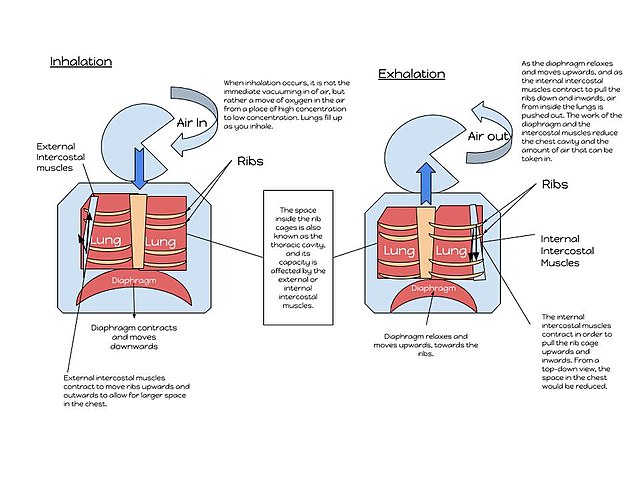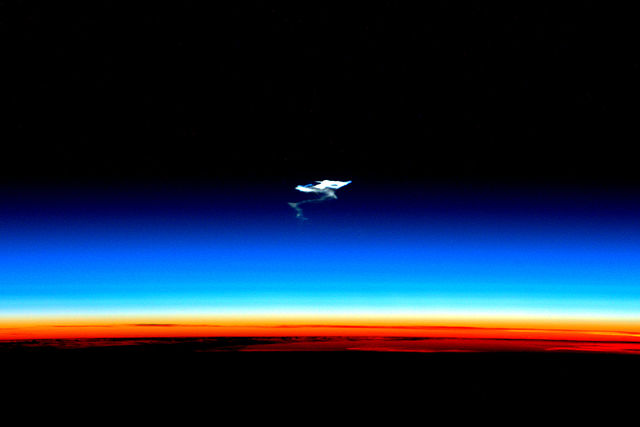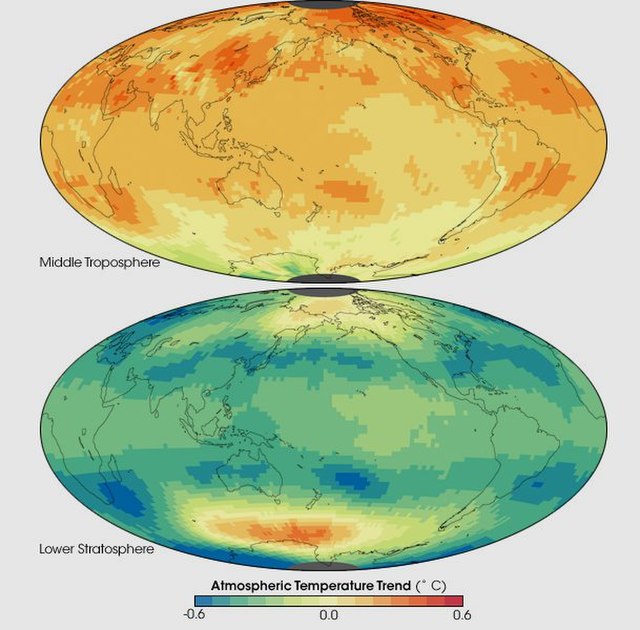Breathing is the rhythmical process of moving air into and out of the lungs to facilitate gas exchange with the internal environment, mostly to flush out carbon dioxide and bring in oxygen.
The effect of the muscles of inhalation in expanding the rib cage. The particular action illustrated here is called the pump handle movement of the rib cage.
The muscles of breathing at rest: inhalation on the left, exhalation on the right. Contracting muscles are shown in red; relaxed muscles in blue. Contraction of the diaphragm generally contributes the most to the expansion of the chest cavity (light blue). However, at the same time, the intercostal muscles pull the ribs upwards (their effect is indicated by arrows) also causing the rib cage to expand during inhalation (see diagram on another side of the page). The relaxation of all these muscles during exhalation causes the rib cage and abdomen (light green) to elastically return to their resting positions. Compare these diagrams with the MRI video at the top of the page.

The muscles of forceful breathing (inhalation and exhalation). The color code is the same as on the left. In addition to a more forceful and extensive contraction of the diaphragm, the intercostal muscles are aided by the accessory muscles of inhalation to exaggerate the movement of the ribs upwards, causing a greater expansion of the rib cage. During exhalation, apart from the relaxation of the muscles of inhalation, the abdominal muscles actively contract to pull the lower edges of the rib cage downwards decreasing the volume of the rib cage, while at the same time pushing the diaphragm upwards deep into the thorax.
This is a diagram showing how inhalation and exhalation is controlled by a variety of muscles, and what that looks like from a general overall view.
The atmosphere of Earth is the layer of gases, known collectively as air, retained by Earth's gravity that surrounds the planet and forms its planetary atmosphere. The atmosphere of Earth creates pressure, absorbs most meteoroids and ultraviolet solar radiation, warms the surface through heat retention, and reduces temperature extremes between day and night, maintaining conditions allowing life and liquid water to exist on the Earth's surface.
Blue light is scattered more than other wavelengths by the gases in the atmosphere, surrounding Earth in a visibly blue layer at the stratosphere, above the clouds of the troposphere, when seen from space on board the ISS at an altitude of 335 km (208 mi) (the Moon is visible as a crescent in the far background).
Afterglow of the troposphere (orange), the stratosphere (blue) and the mesosphere (dark) at which atmospheric entry begins, leaving smoke trails, such as in this case of a spacecraft reentry
A picture of Earth's troposphere with its different cloud types of low to high altitudes casting shadows. Sunlight is reflected off the ocean, after it was filtered into a redish light by passing through much of the troposphere at sunset. The above lying stratosphere can be seen at the horizon as a band of its characteristic glow of blue scattered sunlight.
Temperature trends in two thick layers of the atmosphere as measured between January 1979 and December 2005 by microwave sounding units and advanced microwave sounding units on NOAA weather satellites. The instruments record microwaves emitted from oxygen molecules in the atmosphere. Source:








